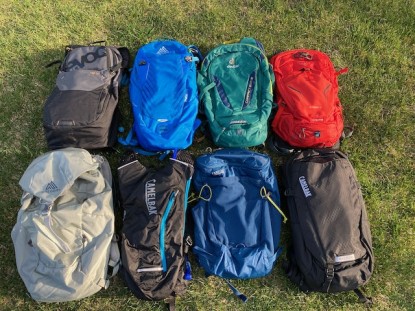Geigerrig RIG 700 Review
Our Verdict
Our Analysis and Test Results
Comfort
Geigregg certainly emphasizes durability in its materials, and while they're very high quality, they unfortunately are a bit rough. The back panel's abrasive mesh is a bit hard to handle against a shirt, much less against bare skin if you're one of those guys/gals.
In addition to the rough materials, the Geigregg pack design tends to become a little bit bulbous like the other packs we tested that didn't have more rigid materials to hold the shape together. This led to the pack having pressure points both in the shoulders and in the center of the back when loaded down. Though this isn't an issue when the pack isn't filled to the brim, we found that with these small 10 liter packs, they typically were filled to the max.
Stability
The overall stability of the RIG was about par. While it didn't slip and slide around as much as the Deuter model, it certainly didn't sport the support of packs like the Osprey Raptor 10 or the EVOC Team FR Lite. We found the RIG to be totally substantial for hiking, but we were looking for a bit more stability when saddling up on the mountain bike.
Durability
The military spec materials used in the Rig 700 makes this the most durable pack we tested. However, the unique bladder included was more suspect to breaking down on us. The extra complexity, as always, also adds extra points of failure. Though we didn't have any failures, we were worrisome about the failure of the pressurizing hose and the bulb. With a simple failure of one of its many hose interruptions, you could totally open the system and not even have suction power to get to your water.
Ease of Drinking
Hands down, the RIG takes the least suction power to get water down your throat, thanks to its pressure system. The basic premise of the pressurized bladder is basic—one hose on one shoulder has a ball similar to that of a blood pressure cuff. A few pumps (or more, based on how much dead space is in your bladder), and the ball fills the empty space inside the bladder with pressurized air, forcing the water through the second tube, leading to your mouth. We really love the ingenuity with this system, but many of our testers didn't find it necessary, while some even found themselves coughing up water that was powered down their throats in the first few uses.
The key question: “How much difference does a pressurized system make?” We found the pressurized system innovative, but by no means a game changer as far as how we effectively we stayed hydrated. Yes, it's easier to get water from the Geigerrig. But we just don't find it is that hard to get water from other systems. And the pressurized system adds more complexity, weight, and costs. That is our take. You can read many reviews online from users who love the pressurized system.
We really thought initially the system would be a bit arduous to actually deal with, but it's a surprisingly simple and easy to use system. It does, however, double the weight from hoses, and we felt like the bulb would get in our way occasionally if we didn't tie it back well enough.
Weight
This is the heaviest pack we tested, by a lot. It is almost as heavy as some 65 liter backpacking backpacks we tested and more than double the weight of many hydration packs we tested. This is not a pack for the ultralight hiker. The weight partially comes from the more complex reservoir with an extra tube, bulb, plastic fitting and neoprene sleeve. However, most of the weight is just do to the burly materials. The pack is made of thick durable ballistic nylon and has big zippers (and lots of them).
Ease of Cleaning
It is very easy to clean the main reservoir and it is the only one marketed as dishwasher safe. Even if you don't use the dishwasher, it is just easy to get your hand inside and clean it with a brush and it's very easy to dry out. Cleaning and drying most hydration bladders is a pain.
As far as cleaning the hoses… it is a bit of a mystery. This video implies all you need to do is run water through the tubes. That might be okay if you are just drinking water. Maybe. But if you use sugar drink mixes we doubt just running water through the hoses is enough to really get them clean. Bacteria loves even the smallest amount of moist sugary drink residue. And, unlike with the reservoir, it's not simple to get the hoses clean and dry. There is no Geigerrig tube cleaning brush available, so find your own or flush the tubes with a soap or sterilizing solution.
Filter Accessory
The separately purchased filtration system for this hydration bladder is very cool. You can refill it from streams and drink from the pack as water passes through filter. It might be good for light multi-day trips. Iodine tabs and a platypus in a backpack might be just as good as well.
Style
This system looks similar to a mobile pressure tester with a reservoir that is somewhat resembling an IV bag. Hypochondriacs beware.






